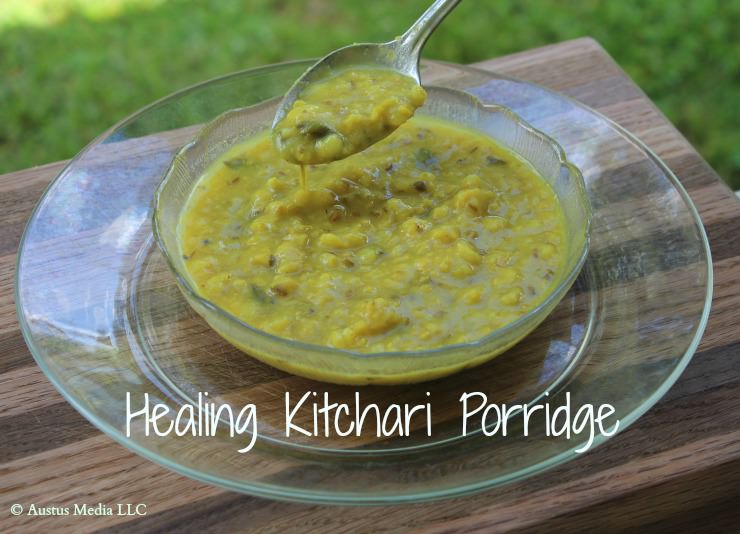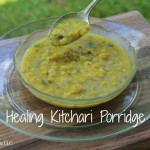Table of Contents[Hide][Show]
 The small, locally owned health food store where I have shopped for nearly 20 years has a wonderful deli and juice bar. It is a huge favorite of the locals. I frequently drop in to see what homemade soups are available on the hot bar. My family consumes so much homemade soup and nourishing bone broth each week that I sometimes find it difficult to keep up. Having a quality source for these foods to lend a hand is very helpful, I can tell you!
The small, locally owned health food store where I have shopped for nearly 20 years has a wonderful deli and juice bar. It is a huge favorite of the locals. I frequently drop in to see what homemade soups are available on the hot bar. My family consumes so much homemade soup and nourishing bone broth each week that I sometimes find it difficult to keep up. Having a quality source for these foods to lend a hand is very helpful, I can tell you!
Recently, I’ve noticed that the hot bar regularly features a pot of kitchari. This was exciting to me, as this is one of the very first traditional dishes I learned about when I began cooking at home. I was forced (thankfully) to stop eating out so much at the urging of my amazing doctor at the time. She is an Ayurvedic physician and an MD.
It’s so neat when something a bit obscure that you’ve enjoyed for a long time starts to mainstream!
Kitchari is a nutritious, tasty and very digestible dish from India.
Indian mothers frequently make for their children when they are feeling under the weather. The soothing nature of this healing and nourishing porridge makes it perfect for a light supper, A brief kitchari fast rests digestion and is a wonderful dish to take to convalescents and mothers who have recently given birth. Another helpful dish for the sick is potassium broth.
Vata Churna Spices Used in Kitchari
The spices are what really make kitchari so special. The spice blend is called Vata Churna which represents all six tastes – sweet, salty, sour, bitter, astringent, and pungent – in a single dish. This is what accounts for the balanced satisfaction a meal of kitchari bestows upon the tastebuds and the digestion with nothing more required. Salted lassi is another common food in the Ayurvedic tradition that uses similar warmth inducing herbs.
Quality Vata Churna is Key to Tasty Kitchari
High quality Vata Churna can be purchased already blended here. You can also easily make it yourself.
To make a batch of Vata Churna that will make several small pots of kitchari, follow these instructions:
- Lightly roast 2 tablespoons each of cumin and coriander seeds in a dry skillet until you smell the nutty fragrance. This only takes a minute or two.
- Remove from heat and cool.
- Process 1/2 teaspoon of whole cardamom seeds with the roasted cumin and coriander in a spice grinder until a fine powder.
- Mix in 1 teaspoon of ground licorice, 1/2 teaspoon of ginger powder, 1/4 teaspoon of hing powder, and 1/4 teaspoon of finely ground sea salt.
Note: The hing powder is a very important spice although it’s not something typically found in the spice drawer of a Western home. Be sure to include as it helps digest the mung beans in the kitchari.
Once you have the Vata Churna spice blend ready either by purchase or making it yourself, you are ready to make a pot of kitchari.
Kitchari Ayurvedic Porridge
The recipe for kitchari can be enjoyed any time of year. Winter is particularly helpful as the herbs are warming on a cold night. Those with a fever or who are recovering from illness particularly benefit.

Homemade Kitchari Porridge
Easy recipe for kitchari that is excellent warming dish for cold winter nights and for those recovering from childbirth, illness, or surgery.
Ingredients
- 1/4 cup sprouted mung beans
- 1 tsp Vata Churna spice blend
- 1/4 cup white basmati rice preferably organic
- 2 3/4 cups filtered water
- 3 Tbl ghee preferably grassfed
- 1 tsp ground cumin preferably organic
- 1 tsp mustard seeds preferably organic
- 1 tsp sea salt
Instructions
-
In a large saucepan, bring 1 1/2 cups of filtered water to a boil.
-
Add the sprouted mung beans, salt, and Vata Churna spices. Bring back to a boil, then cover and reduce heat to a very low simmer.
-
After cooking for one hour, add the rice, 2 tablespoons of ghee, and the remaining 1 1/4 cups water. Bring mixture to a boil again. Stir, and reduce heat to a simmer and cook for an additional 30 minutes.
-
Stir as often as necessary to avoid sticking. Add more water as necessary if the kitchari becomes too thick noting that the proper consistency is of thick gravy.
-
When the kitchari is finished cooking, heat the remaining 1 tablespoon of ghee in a small pan with the mustard seeds and cumin. When the mustard seeds pop, stir the mixture into the kitchari and serve.
-
Refrigerate unused portions and reheat on the stovetop to serve (don't microwave).
Recipe Notes
Sprouted or soaked lentils may be substituted for mung beans if desired.
Sprouted brown or wild rice may be substituted for white rice.
In case of dairy allergy, substitute expeller pressed coconut oil instead of ghee.
Sarah, The Healthy Home Economist
Sources and More Information
Cooking for Life: Ayurvedic Recipes for Good Food and Good Health








I think “hing” is the same as Asaffoetida spice.
Yes it is. 🙂
Is that cooking time correct? A full hour to cook the mung beans (or lentils) and spice and only 30 minutes for the rice?
Yes, rice takes a lot less time to cook than lentils or mung beans.
This is great idea what to cook for my family. Looking through the recipe I’m already sure I’ll like it. I have always liked Indian cuisine
I ate it at one of my Indian friends home.It taste awesome.Love its aroma.I never knew it has lots of health benefits.
Yes, the aroma while it is simmering is amazing!
Thanks for this recipe. I will try it. Any idea if it has an impact on one particular chakra?
Because the spice mix is Vata, it will have a warming effect on the body. Regardless of the predominant dosha of a particular person (Pitta, Vatta, Kapha), when ill … warming is typically required for healing which is why Vata Churna is used for Kitchari. You are welcome to use Pitta (cooling) Churna or Kapha (stimulating) Churna instead if you desire less of a warming effect.
Pure Indian Foods just emailed me after seeing this article … they have recently added organic kitchari to their line (minus the spice blend which they will have available soon too).
http://www.pureindianfoods.com/Buy-Organic-Khichadi-Online-p/kh2.htm?Click=7613
For any Pitta’s out there you can make this dish with more coriander or fresh cilantro to make it a cooler dish.
Ghee is highly clarified and is virtually 100% fat. Is it really a problem for people with dairy allergies?
Jim
Most folks with a dairy intolerance can handle ghee just fine, but I have known a few who cannot. If you are able to try it safely, then do so. Ghee is such a healthy traditional fat!
this is a really interesting ”soup”. I plan to try it this week – but I will substitue my mixed sprouts for the mung bean sprouts, simply because I have them ready at home, and i think supermarket mung bean sprouts are less wholesome than my own.
It’s not really soup … more of a stew.
This looks fantastic, and really easy too (especially with the prepared spice mix), but I guess I have it stuck in my head that the best soups begin with onions and garlic sautéed in butter (and spices added near the end of that step to bring out the flavor) and use bone broth for the liquid. Is it important to follow the recipe as is for any particular reason, or do you think it’s just as beneficial with the addition of butter, onions, garlic, and bone broth?
I would follow the recipe as is. The recipe uses ghee instead of butter and the spices are very synergistic and I would not mess with the flavor by adding onions and garlic.
You really don’t need onions and garlic as the spice mixture includes Hing (aka Heeng or Asofoetida). Hing has a very unique taste and replaces onion and garlic in a lot of Indian recipes. If I remember correctly, some in India do not eat onions or garlic due to religious reasons.